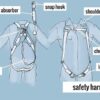
Welcome, everyone, to today’s toolbox talk on hand safety! Our hands are truly remarkable tools that enable us to accomplish a wide range of tasks in our daily lives. From intricate movements to powerful grips, our hands are a testament to the incredible capabilities of the human body. However, these versatile tools are also vulnerable to various hazards that can cause injuries. Today, we will discuss the importance of hand safety, common causes of hand injuries, the irreversible consequences of such injuries, and effective hand safety measures for different hazards. Let’s dive in and learn how we can protect our hands and keep them safe!
The Vulnerability of Our Hands
Our hands are intricately designed with an intricate network of bones, muscles, and joints. They allow us to perform countless activities with precision and finesse. However, this also means that they are susceptible to injuries due to their delicate structure. Unfortunately, our hands are exposed to hazards in our daily lives, both at work and during recreational activities. Whether it’s using power tools, encountering pinch points, handling chemicals and resins, or facing electrical hazards, our hands are at risk. It is crucial to understand these risks and take necessary precautions to avoid potential injuries.
Common Causes of Hand Injuries
Hand injuries can occur due to a variety of reasons, often as a result of work-related activities or accidents. Some common causes of hand injuries include:
- Power tools: Mishandling or improper use of power tools can lead to severe injuries, causing damage to tissues, tendons, and nerves.
- Pinch points: Placing our hands in pinch points, such as between moving parts or in tight spaces, can result in crush injuries.
- Chemicals and resins: Exposure to harmful chemicals and resins can cause burns, blisters, or irritating rashes on the skin.
- Electrical burns: Accidents involving electricity can lead to severe burns and tissue damage.
These examples highlight the importance of recognizing potential hazards and implementing safety measures to protect our hands.
The Irreversible Consequences of Hand Injuries
Hand injuries can have significant and lasting consequences. The loss of fingers or hands is not only physically debilitating but can also impact one’s ability to perform everyday tasks and engage in certain occupations. It is essential to create awareness about hand safety and make conscious efforts to prevent injuries. Protecting our hands and fingers from potential hazards is crucial because nothing can truly compensate for the loss of these vital body parts.
Hand Safety Measures for Various Hazards
To ensure hand safety, it is essential to implement appropriate measures based on the specific hazards we encounter. Here are some effective hand safety measures for different hazards:
- Protective Gloves: Wearing the right type of protective gloves is one of the most effective ways to safeguard our hands. Different types of gloves are designed to provide protection against specific hazards. Some examples include:
- Cut-resistant gloves: Ideal for tasks involving sharp objects or materials.
- Chemical-resistant gloves: Protect against harmful chemicals and resins.
- Heat-resistant gloves: Provide protection against high temperatures and burns.
- Insulated gloves: Guard against electrical shocks and burns.
- Impact-resistant gloves: Offer protection from impact injuries and vibrations.
- Protective Guards on Machinery: Installing and maintaining protective guards on machinery and equipment can prevent accidents involving pinch points, moving parts, and sharp edges. Regular inspection and maintenance of these guards are essential to ensure their effectiveness in minimizing the risk of hand injuries.
- Safe Work Practices: Adopting safe work practices is crucial in reducing the likelihood of hand injuries. Some examples of safe work practices include:
- Proper training: Ensure that workers receive adequate training on how to use tools and equipment safely.Tool maintenance: Regularly inspect and maintain tools to keep them in good working condition, minimizing the risk of accidents caused by faulty equipment.Equipment de-energization: Always turn off and lock out machinery before performing maintenance or repairs to prevent accidental activation that could cause hand injuries.
Developing a Hand Safety Culture
To truly prioritize hand safety, it is essential to develop a culture that values and promotes it. Here are some key steps to building a hand safety culture:
- Building Awareness: Creating awareness about the importance of hand safety is the first step toward developing a culture that prioritizes hand protection. Share relevant information and resources with your team, such as the risks associated with hand injuries and the preventive measures that can be taken. Encourage open discussions about potential hazards and ways to mitigate them.
- Implementing a Hand Safety Program: Establishing a comprehensive hand safety program within your organization can greatly contribute to reducing hand injuries. This program should include:
- Identifying hazards: Conduct thorough assessments to identify potential hand hazards in the workplace.
- Guidelines for protective measures: Develop clear guidelines on the use of personal protective equipment, safe work practices, and the proper handling of hazardous materials.
- Training and education: Provide regular training sessions to ensure that employees are aware of hand safety protocols and know how to effectively implement them.
- Regular review and updates: Continuously evaluate and update the hand safety program to address any emerging hazards or changes in work processes.
- Encouraging Personal Responsibility: Each individual has a role to play in maintaining hand safety. Encourage personal responsibility by promoting the use of protective gear, emphasizing the importance of following safe work practices, and empowering employees to report hazards or unsafe conditions promptly.
By implementing these measures and fostering a culture of hand safety, we can significantly reduce the risk of hand injuries and create a safer working environment for everyone.
Conclusion
Our hands are truly remarkable and invaluable. They enable us to perform extraordinary tasks, but they are also vulnerable to various hazards. By understanding the risks, implementing appropriate safety measures, and fostering a culture of hand safety, we can protect our hands and prevent unnecessary injuries. Let’s make hand safety a priority and ensure that everyone goes home with their hands safe and sound!
FAQs (Frequently Asked Questions)
- Q: Why are hand injuries particularly significant?
- A: Our hands are vital for performing numerous daily tasks, and injuries to our hands can have lasting consequences, impacting our ability to function and engage in various activities.
- Q: What are some common hand hazards in the workplace?
- A: Common hand hazards include cuts, crush injuries, burns, punctures, pinch points, and exposure to harmful substances.
- Q: How do I choose the right gloves for hand protection?
- A: Consider the specific hazards present in your workplace and select gloves made from suitable materials. Ensure proper fit and inspect for any damage before use.
- Q: Why is it important to maintain and inspect protective guards on machinery?
- A: Protective guards are designed to prevent accidents involving moving parts and pinch points. Regular inspection and maintenance ensure their effectiveness in minimizing hand injury risks.
- Q: What should I do if I notice a potential hand hazard in my work environment?
- A: Report the hazard to your supervisor or the designated authority immediately. Prompt reporting helps prevent accidents and allows for necessary corrective actions to be taken.



Thank You? Bless you!